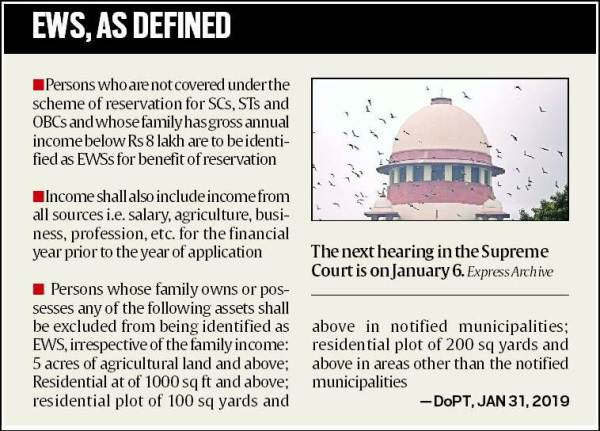Revisiting definition of EWS
Context
-
A three member-committee set up to examine the income criteria for determining the economically weaker sections (EWS) is expected to submit its report to the Centre within the next few days.
Why was the committee set up?
- It was set up after the Supreme Court questioned the income criteria for defining EWS, and termed it “arbitrary”, noting that the ceiling for determining EWS (Rs 8 lakh) is the same as the limit for determining the other backward classes (OBC) “creamy layer” for reservation for the children of people outside of government.
Credit: IE
When were the income criteria fixed?
- The criteria for EWS and OBC quotas, as notified for NEET admissions in September, are the same as criteria notified for employment and admission on January 31, 2019 by the Department of Personnel and Training (DoPT) based on the 103rd Amendment to the Constitution.
- Under the 2019 notification, persons who are not covered under the scheme of reservation for SCs, STs and OBCs, and whose family has gross annual income below Rs 8 lakh, are to be identified as EWSs for benefit of reservation.
- It also specifies what constitutes “income”, and excludes some persons from the EWS category if their families possess assets specified in the notification.
- EWS reservation was granted based on the recommendations of a commission headed by Major General (retd) S R Sinho.
- The Sinho Commission recommended that all below poverty line (BPL) families within the general category as notified from time to time, and also all families whose annual family income from all sources is below the taxable limit, should be identified as EBCs (economically backward classes).
- The present income ceiling of Rs 8 lakh fixed for EWS is the same as that for OBCs for quotas for people outside of government. For the OBC quota in government, there is a different criteria based on the ranks of the parents of the candidate. Outside of government, there is an income criteria, which was raised from Rs 6 lakh to Rs 8 lakh in 2017.
How was the ceiling decided?
- The annual income limit of Rs 8 lakh per annum for EWS category was decided after detailed deliberations by the government.
- Since establishing of BPL is open to debate and in order to maintain parity with similar categories, it would be appropriate to apply the income/wealth test made applicable in the case of OBCs for the purpose of exclusion from the benefit of reservation.
Why has the Supreme Court termed the income ceiling arbitrary?
- The Supreme Court observed:
- “The income limit in the criteria for the determination of the creamy layer of the OBC category and the EWS category is the same, namely, Rs 8 lakhs. While the creamy layer in the OBC category is identified for excluding a section of the community that has ‘economically progressed’ to such an extent that the social backwardness of the community diminishes, the EWS category is identified to include the segment which is ‘poorer’ when compared to the rest of the community.
- Therefore
- (a) the income criterion in respect of the OBC category is aimed at exclusion from a class while in the case of the EWS category, it is aimed at inclusion; and
- (b) the OBC category is socially and educationally backward and, therefore, has additional impediments to overcome as compared to those belonging to the general category. In these circumstances, would it be arbitrary to provide the same income limit both for the OBC and EWS categories.”
- The court also questioned:
- “on what basis has the asset exception been arrived at and was any exercise undertaken for that purpose; whether municipalities as required under the exception have been notified; The reason why the residential flat criterion does not differentiate between metropolitan and non-metropolitan areas.”
Source: IE
Visit Abhiyan PEDIA (One of the Most Followed / Recommended) for UPSC Revisions: Click Here
IAS Abhiyan is now on Telegram: Click on the Below link to Join our Channels to stay Updated
IAS Abhiyan Official: Click Here to Join
For UPSC Mains Value Edition (Facts, Quotes, Best Practices, Case Studies): Click Here to Join


